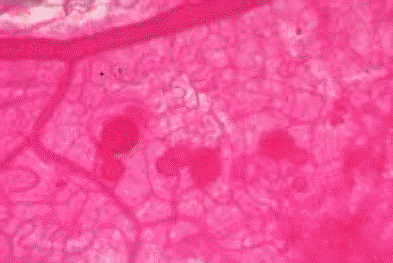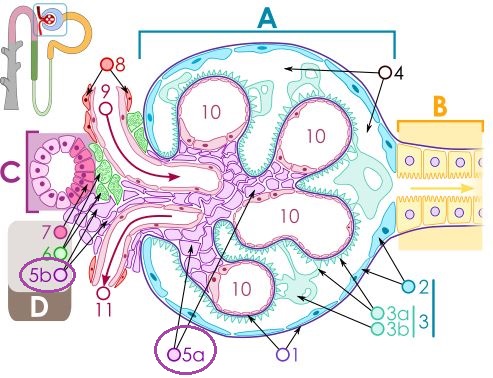|
|
Medical Pharmacology Chapter 29: Diabetes
Late Complications of Diabetes
Atherosclerosis: more extensive and occurs earlier (accelerated course)
Lesions initiated by oxidized LDL
Increased platelet adhesiveness
Increase secretion of endothelin-1
Endothelin-1: powerful vasoconstrictor; vascular smooth muscle mitogen
Decreased nitric oxide production:
Nitric oxide: vasodilator; anti-mitogenic in vascular smooth muscle
Diabetes: procoagulant state
Increased levels of tissue factor
Deficiency of tissue factor pathway inhibitor type 1
Factor VIII elevated
Impaired fibrolysis: (probably as a result of increased tPA inhibitor, type 1)
Symptoms:
Intermittent claudication, gangrene, impotence (vascular)
Coronary artery disease; stroke:common
Silent myocardial infarction
 |
|
![]() Diabetic retinopathy: leading cause of
blindness in the U.S.
Diabetic retinopathy: leading cause of
blindness in the U.S.
Retinopathic lesions
Simple (background)
Proliferative
Progression
Increased capillary permeability
Retinal capillary occlusion (saccular and fusiform aneurysms)
Vascular lesions associated with:
Proliferation of lining endothelial cells
Pericyte loss around vessels
Proliferative retinopathy is associated with new vessel formation and scarring.
|
|
|
![]() Renal disease: leading cause of death and
disability due to diabetes.
Renal disease: leading cause of death and
disability due to diabetes.
50% of end-stage renal disease in United States: diabetic nephropathy
Complication rates:
35% of IDDM patients
15 to 60% of NIDDM patients (ethnic background dependent; highest -- Pima Indians;lowest- Europeans)
Two pathologic patterns
Diffuse (more common)
Widening of glomerular basement membrane
Menangial thickening
 |
|
|
Nodular
Periodic acid-Schiff-positive material: deposited at glomerular tuft periphery
Hyalinization of afferent and efferent arterioles
deposition of albumin and other proteins in tubules and glomeruli
|
|
|
![]() Major cause of morbidity
Major cause of morbidity
Peripheral polyneuropathy presents most commonly.
Bilateral, characterized by:
Numbness
Paresthesias
Severe hyperesthesias
Pain (deep-seeded, severe)
Mononeuropathy is associated with:
Wrist drop
Foot drop
Paralysis of third, fourth or sixth cranial nerve
Radiculopathy
Sensory syndrome: pain distribution of one or more spinal nerves, usually in chest wall or abdomen
Autonomic neuropathy
Significant target: gastrointestinal tract -- symptoms include:
Esophageal dysfunction
Delayed gastric emptying
Constipation or diarrhea
Orthostatic hypotension
Syncope
Cardiopulmonary arrest; sudden death
Bladder dysfunction (may require chronic catheter drainage)
Impotence/retrograde ejaculation
Pain:
Although opioids may be used (e.g. tramadol (Ultram) side effects make these agents problematic for long-term therapy.
Other options include:
Gabapentin, prgabalin and carbamazepine (from the anti-seizure medication class)
Amitriptyline, imipramine, desipramine and nortriptyline from the tricycylic antidepressant class.
|
|
|
![]() Secondary to diabetic
neuropathy is abnormal pressure
distribution
Secondary to diabetic
neuropathy is abnormal pressure
distribution
Vascular disease (decreased perfusion): augments ulcer development
Infection: common (multiple organisms)
Initial antibiotic treatment (until culture results are available):
ampicillin-sulbactam plus gentamycin or aztreonam
Autonomic Dysfunction and Diabetes Mellitus
Initial finding: often asymptomatic abnormal vagal function (reduced heart rate variation with deep breathing)
Loss of myelinated and non-myelinated small nerve fibers in splanchnic distribution, carotid sinus, and vagus nerve
Disturbances and gut motility.
Nausea/vomiting.
Achlorhydria.
Bowel incontinence.
Impotence
Urinary incontinence.
Pupillary abnormalities.
Postural hypotension.
Symptoms of hypoglycemia -- blunted or detectable because damage to sympathetic adrenal gland innervation prevents epinephrine release.
Autonomic dysfunction may lengthen Q-T interval, an effect which may be associated with sudden cardiac death.
Karam, J. H., Pancreatic Hormones and Antidiabetic Drugs, in Basic and Clinical Pharmacology, (Katzung, B. G., ed) Appleton-Lange, 1998, pp 684-703
Foster, D. W., Diabetes Mellitus, In Harrison's Principles of Internal Medicine 14th edition, (Isselbacher, K.J., Braunwald, E., Wilson, J.D., Martin, J.B., Fauci, A.S. and Kasper, D.L., eds) McGraw-Hill, Inc (Health Professions Division), 1998, pp 2060-2080
|
This Web-based pharmacology and disease-based integrated teaching site is based on reference materials, that are believed reliable and consistent with standards accepted at the time of development. Possibility of human error and on-going research and development in medical sciences do not allow assurance that the information contained herein is in every respect accurate or complete. Users should confirm the information contained herein with other sources. This site should only be considered as a teaching aid for undergraduate and graduate biomedical education and is intended only as a teaching site. Information contained here should not be used for patient management and should not be used as a substitute for consultation with practicing medical professionals. Users of this website should check the product information sheet included in the package of any drug they plan to administer to be certain that the information contained in this site is accurate and that changes have not been made in the recommended dose or in the contraindications for administration. Advertisements that appear on this site are not reviewed for content accuracy and it is the responsibility of users of this website to make individual assessments concerning this information. Medical or other information thus obtained should not be used as a substitute for consultation with practicing medical or scientific or other professionals. |